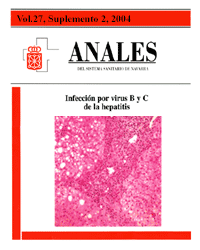Chronic Hepatitis B Virus infection
Keywords:
Replicación viral. Hepatitis crónica. Cirrosis.Abstract
Many factors are involved in the pathogenesis of chronic hepatitis B virus infection (HBV), such as, for example, characteristics of the virus, ethanol intake, coinfection with other viruses (HCV, HIV, HDV), and therapeutic interventions such as the use of cytotoxic drugs or immunosuppressors, or specific antiviral agents. The clinical, pathological and serological characteristics of chronic hepatitis B virus infection are besides very heterogeneous. Chronic HBV infection can be recognised facing persistence of the Australia antigen (HBsAg) for more than six months. The presence of HBeAg is usually associated with active viral replication and can be measured by the quantity of DNA-HBV present in the serum or by the hepatic expression of HBcAg. The hepatic damage that is produced in chronic hepatitis due to HBV is not so much due to the effect of the virus on the hepatocytes as to the immune reaction that it provokes in the host. For this reason a certain inversely proportionate correlation can be observed between the intensity of viral replication and the degree of hepatic inflammation. The presence of active chronic hepatitis in the initial biopsy has not been associated with the development of cirrhosis, nor does the histological diagnosis of persistent chronic hepatitis guarantee that cirrhosis will be developed in the future.Downloads
Downloads
Published
How to Cite
Issue
Section
License
La revista Anales del Sistema Sanitario de Navarra es publicada por el Departamento de Salud del Gobierno de Navarra (España), quien conserva los derechos patrimoniales (copyright ) sobre el artículo publicado y favorece y permite la difusión del mismo bajo licencia Creative Commons Reconocimiento-CompartirIgual 4.0 Internacional (CC BY-SA 4.0). Esta licencia permite copiar, usar, difundir, transmitir y exponer públicamente el artículo, siempre que siempre que se cite la autoría y la publicación inicial en Anales del Sistema Sanitario de Navarra, y se distinga la existencia de esta licencia de uso.








